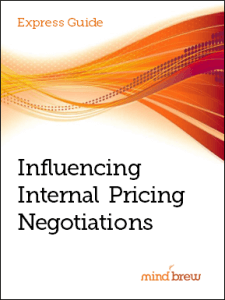As pricing professionals, we spend a lot of time thinking about how to influence the pricing decisions being made by our prospects and customers, right? And of course, we absolutely hate it when we leave money on the table through unnecessary discounts, inaccurate prices, or gamesmanship in negotiations.
But have you ever wondered just how much margin you lose negotiating with yourself?
In researching a new guide for the PricingBrew Journal, Influencing Internal Pricing Negotiations: Ten Strategies for Negotiating Better Pricing Outcomes with Other Decision-Makers Inside Your Company, we learned that the problem could be even worse than we suspected and internal pricing negotiations could actually be responsible for a fairly sizable chunk of the margin erosion we’re all fighting so hard to avoid.
In other words, the discussions, negotiations, and all-out battles that are occurring between different people and groups within our own organizations could be eroding our margins before our customers and competitors even have a chance to weigh in!
As we were soliciting the most effective internal negotiation strategies from leading practitioners, we heard a number of anecdotes that underscore the magnitude of issue, including this head-shaker:
We’ve spent days working up a solid, value-based quote on a piece of new business…only to have the sales rep and her manager drop the price another 15% on the drive over to the prospect’s site…because the sales rep convinced her manager the prospect would never go for the quote we developed. That’s 15% right off the top…just talking amongst ourselves…without the prospect ever saying a word…or even seeing the original quote.
Sound familiar? Likely so, because this sort of thing is apparently happening a lot. And not just with the sales groups—people also reported having some pretty tough negotiations with their product management and finance groups, too.
Fortunately, we were able to identify ten effective strategies and practices to deal with the issue. Unfortunately, customers and competitors aren’t the only ones you need to be thinking about. But you already knew that, right?













